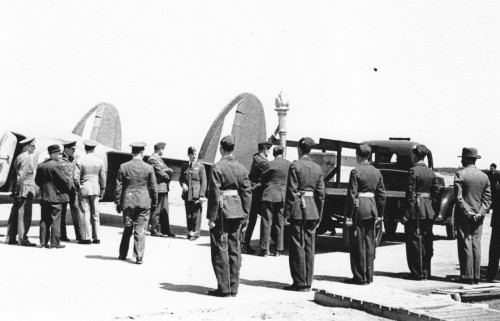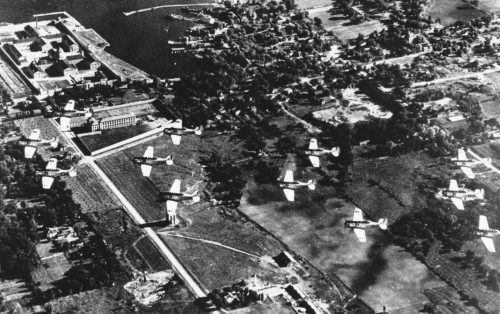Throughout the years of training at No. 31 S.F.T.S., most of the pilots seemed to have been guilty of low flying at some point. Most also returned to base safely, some trailing the tell-tale signs of wire or branches. The fact that they would be punished and possibly grounded didn’t deter them. One returned with a length of telephone wire caught in a fin with the fin and rudder damaged, and was placed on charge. The article acknowledged the temptation it was to trainee pilots to mimic the fighter pilots in combat as they “darted and dodged and strafed.” During 1941, there were 170 fatal training accidents across Canada, forty of them being attributed to unauthorized low flying and aerobatics by pilots whose skills did not match their daring, the article reported.
The Thousand Islands Bridge was always a temptation to the trainees and a number will admit to flying under it, although regulations forbade it. At No. 31 instructors were sent out to see that it wasn’t broken but when George Holloway saw three pupils fly under the bridge in formation, he thought, “Let them go; if they can do that, they can do anything.” One ex-F.A.A. pilot recalls his flight: “I was on a very boring routine training exercise when at about 3,000 feet I saw the bridge so I just peeled off and dived straight for it. I suppose by the time I got to river level I had pushed the old Harvard to over 200 mph which would mean that the mile I was at low level would be about ten seconds. No wonder that nobody got my number, especially as the U.S. was not then engaged in
the war.”
While prohibited, flying under the bridge wasn’t as dangerous as some of the other activities they engaged in. Stories of complaints lodged by northern New York residents appeared under the headline: “Dangerous Flying of Airmen From Canada Draws U.S. Ire.” A Syracuse paper carried a story from Watertown about a “succession of visits during the past several weeks by a lone flier in a yellow Harvard trainer of the Royal Canadian Air Force schools” that had caused “grave concern to the Fire Chief and many householders in the area.” The article said that, although the citizens had exhibited enjoyment in the presence of the Dominion pilots who occasionally disport over Jefferson County and conduct themselves with decorum at a respectful and legal altitude, “the flier to whom reference is made has endangered not only his own life but the lives and property of residents, skimming the tree tops, banking until his plane appears to stand on the edge of one wing.”
The Potsdam newspaper had an article concerning a Canadian training plane that had stunted over their village.
“The exhibition opened with zooming power dives that brought the villagers into the street to stand in open-mouthed wonder and then scurry suddenly into doorways as it seemed the plane must crash, but the pilot pulled out and levelled off each time, barely skimming the roof tops. The exhibition was completed with a performance of hair-raising barrel rolls and falling leaf manoeuvres.”
Another report was of a Canadian pilot who “flew so low over the town of Lyme that he carried back to his airfield several rods of wire from a People’s Telephone Company line that he fouled over the Perch River.”
The C/O at No. 31 denied that any pilots from that station were involved, and suggested that the Harvards could have come from stations farther afield. There was a suggestion that the adventurer could have been flying out of Arnprior, which was a flying instructors’ school. A Canadian pilot who was among the first graduates commented: “Ninety-nine percent of us went up and did aerobatics, instead of practicing the set sequences. Low flying was especially exciting: kicking the treetops, flying around just like a high-speed car.”
VICTORY LOAN PARADE JUNE 10, 1941
The Victory Loan flame that would lead the parade was brought over from Trenton and was escorted by a formation of Harvards. A detachment of 100 R.A.F. airmen led the parade.


Next Chapter: 12. First Canadian F.A.A. Pilots Graduate In Canada